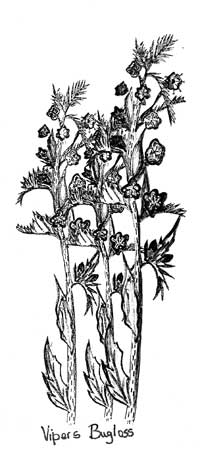|
|
|
| Colney Nature Watch |
| A series of articles on the wild life in London Colney |
| Vipers bugloss |

Each June, a patch of mauve flowers appear on my lawn. Ground hugging plants, they disappear by September. I decided it was time I identified these flowers. I searched through four books on wild flowers, but could not find these flowers anywhere. So I did what I should have done in the first place – ask some local experts! They all concurred – the purple flowers were vipers bugloss, whose Latin name is echium vulgare.
So what had gone wrong? Why were my books so useless? I looked up vipers bugloss in the index of the most prestigious book, which contained drawings by a top botanical artist, and the flowers were arranged by colour. Vipers bugloss was in the pink section and I'd looked it up in the mauve section. I could not fault the drawing, except that it was three times larger than the actual flower. The book told me the flowers start pink and later turn blue. I turned to another book, which showed photos of wild flowers by the month they appeared. I'd searched in the July section, but the book showed a good photo of the flower in June.
It just shows, if you want to identify wild flowers from a book, you've got to be really alert. I read in one book that vipers bugloss thrives particularly in south east England, and particularly likes growing in light chalky soils that are not too wet. I learnt that in olden times herbalists would boil viper's bugloss' seeds in wine, to give to new mothers who were having difficulty lactating. I learnt that there is a rare sub species, found growing in only three secret locations in Cornwall. I also learnt that if you leave vipers bugloss alone - it will grow into a small bush.<br>
Another problem with identifying wild flowers, and trees is you often come across hybrids. Primroses and cowslips readily interbreed with each other, and also with garden plants.
Identifying wild birds is so much easier! I was cycling beyond Shenley when I came to a road I'd never been along. It wasn't really suitable for cars. The road was called Crossoaks Lane. Halfway along I stopped to admire the view across the Vale of St Albans. There was a large bird soaring in the thermals above Pursley Great Wood. It flew in tight circles, and was brown. To my mind, there was only one bird it could be - a red kite. As you know, red kites were once common urban scavengers for meat scraps, and in rural areas they ate small mammals and nestlings. However, huntsmen and game keepers brought them to extinction in England in the last century. A few years ago, red kites were imported from abroad, carefully nurtured and released with the support of local people. A few years back, I went to Christmas Common, in Buckinghamshire, where they were released. They have certainly thrived, and I saw several of them, soaring upwards, or swooping low, to pick up a young rabbit or vole. So I feel I know red kites, and if someone asks me how I know a bird is a red kite, I say "it just is". And this gives rise to a word I've only ever seen in an ornithological text, the word "jizz". I've never found the word in a conventional dictionary. All it means is that if you see a bird behaving in a certain place, at a certain time of year and it looks like your target species, than it "just is"
I looked at the red kite through my binoculars, and saw the pale grey markings on the wings - that confirmed it, the bird could only be a red kite.
So there is at least one red kite living in Hertfordshire, not far from our village. Lets hope it meets a mate, and there are more! |
|
|




